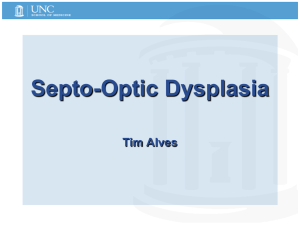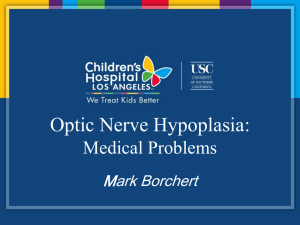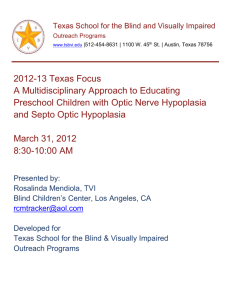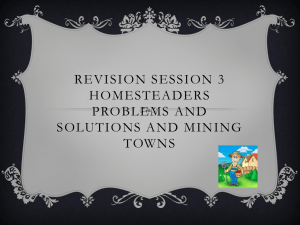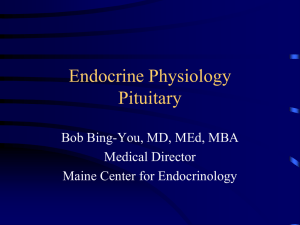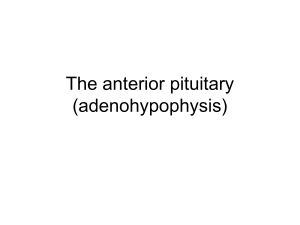SEPTO-OPTIC DYSPLASIA - Statewide Vision Resource Centre
advertisement
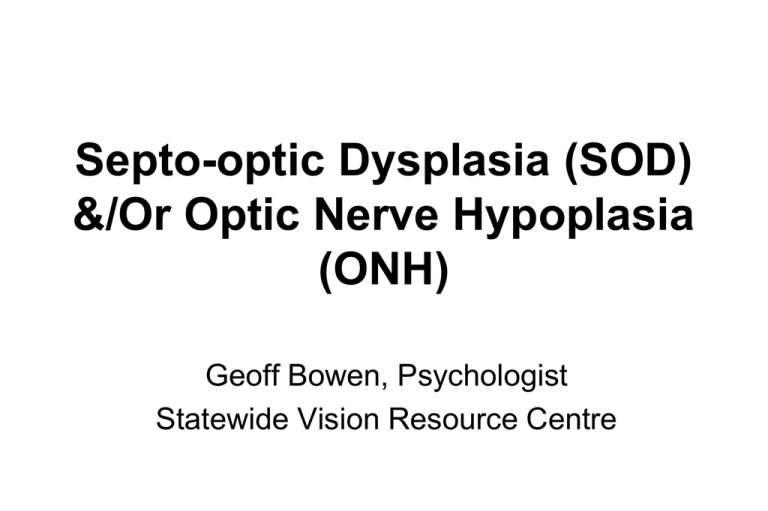
Septo-optic Dysplasia (SOD) &/Or Optic Nerve Hypoplasia (ONH) Geoff Bowen, Psychologist Statewide Vision Resource Centre Born blind and probably autistic, Thomas Green Wiggins was known as Blind Tom. He sustained a career that spanned 50 years and performed for all manner of distinguished critics and fans, including Mark Twain, and he was the first African-American to perform at the White House. Did he have SOD/ONH? Biography of Blind Tom by Australian writer Deirdre O'Connell Reference of Note Texas School for the Blind Texas Focus: Learning From Near to Far Septo-Optic Dysplasia/Optic Nerve Hypoplasia & Autism Spectrum Disorders June 10, 2010 Terese Pawletko, Licensed Psychologist/Certified School Psychologist Portsmouth, NH SOD: Definition • SOD previously termed de Morsier syndrome, was first described by Reeves in 1941 as an absence of the septum pellucidum in association with optic nerve abnormalities. • Variable combination of midline forebrain abnormalities, eye abnormalities and pituitary abnormalities. • 2/3 features to make the diagnosis: − Optic nerve hypoplasia − Absence of the septum pellucidum − Thinning of the corpus callosum − Pituitary hormone deficiency (added by Hoyt WF, Kaplan SL, Grumbach MM, et al. Septo-optic dysplasia and pituitary dwarfism. Lancet. 1970;1:893–894. ) • “SOD can present at birth in association with multiple congenital abnormalities or much later on when growth failure occurs in a child also noted to have visual abnormalities (although not necessarily as may just have growth failure with mild undetected visual abnormalities). The child may present with strabismus, nystagmus, or other visual abnormalities. In the majority of cases, the earlier the diagnosis is made the better the outcome, as untreated hormonal abnormalities place an additional neurodevelopmental burden on a child already compromised by visual impairment, and also place the patient at risk of hypoglycaemia, adrenal crises and consequently death.” Septo-optic dysplasia Emma A Webb and Mehul T Dattani see reference 1 below) On The Increase!? • ONH was very rare with only 35 cases noted in the English language medical literature before 1970. • ONH is on the increase - today considered the most common single cause of congenital blindness in the industrialized world. • Swedish study (1997) an incidence of 6.7 out of 100,000 births or about 1 in 15,000 births. On The Increase!? • ONH = leading cause of childhood visual impairment in the US and Europe – 12% of children with VI (Blohme et al, 200, Hatton et al, 2007) or 1/10000 chn < 16 years of age (Patel et al 2006; Garcia-Filion et al 2008). • Sixfold increase from 1977 estimate of 1.8/100,000 (Jan et al 1977) On The Increase!? • ONH blindness is more common today than blindness due to retinopathy of prematurity (ROP). • Now the most common cause of blindness in children in the USA • Outdistancing many other birth defects which are currently more familiar, including congenital muscular dystrophy and Williams Syndrome. On The Increase!? • On our books 14 SOD/ONH and 24 ONH in 2009 • 11 and 32 in 2012. • NB: To date, there is no pre-natal screening to detect ONH blindness. SOD or ONH • The term Septo-Optic Dysplasia is slowly losing favour with physicians and researchers because the presence or absence of the septum pellucidum does not seem to be a defining aspect of the diagnosis. ONH is now the preferred term. • Some individuals can have an absent septum with no negative consequences. • Absence of SP in Garcia-Filion et al 2008 unrelated to development (was associated with CCH) • Absence of SP (with no pituitary or cerebral abnormalities) was associated with “normal neurodevelopmental parameters” in language, IQ, behavioral functioning - “neurodevelopmentally and endocrinologically inconsequential unless accompanied by posterior pituitary ectopia or cerebral hemispheric abnormalities” (p. 70, Brodsky & Glazier 1993) • Optic nerve hypoplasia (ONH) has been described as an increasingly prevalent cause of congenital blindness. Its association with hypopituitarism and absent septum pellucidum has been recognized for more than 40 years as "septo-optic dysplasia" or "de Morsier syndrome." More recent studies have suggested that these associations are independent of one another (Borchert, 2012). Forebrain Abnormalities • In 75-80% of patients • Absence of septum pellucidum • Absence of corpus callosum • Cerebellar hypoplasia • Schizencephaly Consequences Of Forebrain Anomalies • Fits • Behavioural difficulties • Learning difficulties • Developmental delay • Hemiplegia Optic Nerve Hypoplasia • Unilateral/bilateral • Bilateral commoner • Associated with anopthalmia/micropthalmia • Visual impairment variable - complete to compensated VISUAL FEATURES • Optic nerve and chiasm hypoplasia (decreased # of fibers). Clinical signs: small optic disc, double ring sign and abnormal retinal vasculature. • Can affect one or both (80% of ONH, impact can be asymmetrical) eyes. • Visual acuity (may be near normal to NLP); high refractive errors (80% of bilateral in legally bl. range.) VISUAL FEATURES • Note: degree of visual impairment correlated with presence of severe pituitary anomaly (Riedl et al 2008) • May have field restrictions • May have color blindness • Nystagmus (may be ‘wandering’ if NLP)\ VISUAL FEATURES • Strabismus • May lack of depth perception if amblyopic • May have mild photophobia (and squint, lower their head, avoid light by turning away, resist participating in outdoor activities) • Microphthalmia, colobomas of the iris/choroids/retina Pituitary Gland • Develops from the oral cavity in the embryo and the brain (hypothalamus) • 5 different cell types in anterior pituitary producing 6 different hormones • Secretion of hormones regulated by hypothalamus Pituitary Hormones • • • • • • • • • Adrenocorticotrophic Hormone (ACTH) Thyroid Stimulating Hormone (TSH) Lutenising Hormone (LH) Arginine vasopressin (ADH) Oxytocin Follical Stimulating Hormone (FSH) Growth Hormone Deficiency (GHD) Gonadotrophic Releasing Hormone (GnRH) Multi Pituitary Hormone Deficiency (MPHD) Anterior Pituitary Gland • Growth hormone: growth and helps maintain normal blood sugar levels in children; increases bone strength, muscle mass and decreases fat mass and heart disease in adults. • ACTH: regulates production of cortisol and androgens from adrenal glands; cortisol essential for normal well-being and to fight stress and infection. Anterior Pituitary Gland • Prolactin: important for lactation, ?immune system • FSH, LH: important for puberty and fertility; LH important for normal development of males and for descent of testes into scrotum • TSH: important for regulation of thyroid gland and thyroxine production Posterior Pituitary Gland • Vasopressin: important for normal fluid balance retains water by controlling reabsorption of water in kidney tubules • Oxytocin: important for parturition (birth) and ejection of milk Pituitary Hormone Deficiency • GH: poor growth with eventual short stature, possibly increased incidence of myocardial infarction. • Prolactin: no lactation. • ACTH: low cortisol leading to low blood sugar, lethargy, inability to fight stress and infection, low blood pressure, low sodium level in blood, collapse Pituitary Hormone Deficiency • FSH, LH: inadequate sexual development in males, lack of puberty, lack of fertility. • TSH: lack of thyroxine with slowness, cold intolerance, constipation, growth failure, mental retardation if not picked up early. • Vasopressin: diabetes insipidus with excessive urinary output. Complexity Of Hypothalamo-pituitary Development • Early puberty: can be explained on basis of hypothalamic involvement • Occasionally mixed involvement of hypothalamus and pituitary Clinical Features Of SOD • Conjugated jaundice • Neurological features • Variable visual loss • Impaired sense of smell • Endocrine features • Behavioural disturbances e.g.. Autism • Sleep disturbance Table Next from: Septo-optic dysplasia Emma A Webb1 and Mehul T Dattani1 European Journal of Human Genetics (2010) 18, 393–397; doi:10.1038/ejhg.2009.125; published online 22 July 2009. Management Of SOD • Support from Neurologists and Ophthalmologists: treatment of convulsions • Mainstay of treatment: endocrine Endocrine Replacement • Growth hormone: daily subcutaneous injections. • Hydrocortisone: X3 doses daily; adjustment with illness/stress. • Desmopressin DDAVP: nasal/oral (Minirin) • Thyroxine • Ethinyloestradiol/testosterone Investigations • MRI scan of brain • Visual evoked responses/electro-retinogram • Routine electrolyte measurement • Thyroid function tests Investigations • Pituitary function tests: glucagon/insulin/LHRH/TRH • Fluid balance Monitoring • Evolving - new endocrine features may develop. • Monitoring of growth rate at regular intervals. • Monitoring through puberty. • Regular checks of thyroid function, watch fluid balance. Long-term Outlook • • • • • • • Short stature Developmental/intellectual impairment Fits, hemiparesis etc Impaired fertility Visual impairment Sleep/behavioural difficulties Obesity Why Do You Get SOD? • Largely unclear • Commoner in young mothers • Development of pituitary gland, forebrain, olfactory bulbs and eyes all from the same part of the early embryo. Problems occur at 3-6 weeks of gestation • Environment and teratogens Why Do You Get SOD? • “It is likely that although other genetic abnormalities are likely to be identified in the future, environmental factors such as drugs, alcohol and anterior cerebral artery supply during the neonatal period may also play a significant role in the aetiology of SOD.” Septo-optic dysplasia Emma A Webb1 and Mehul T Dattani see reference above) Genetics Of SOD • Mutations in HESX1: Dominant or recessive. • Occasionally, one abnormal copy of gene carried with no phenotype in parent but child affected. • Number of other developmental genes may also be involved: all extrapolated from animal studies. Genetics Of SOD • Research is ongoing into the genetic aetiology of SOD. To date, the overall frequency of pathological genetic mutations identified in the SOD population is low, with no mutations identified in many familial cases, suggesting that mutations in other known or unknown genes may have a role in this complex disorder. Research • New genes involved in SOD: what is their function? • Why the variability in severity • Sleep/wake cycles in children with SOD and hypothalamic involvement and the use of melatonin (10-18 year olds) The following statement are NOT TRUE according to current research: – ONH occurs in clusters due to use of pesticides in the environment. – The associated midline brain anomalies have a profound effect on the visual outcome and/or spatial orientation of these patients. – All mothers of children with ONH were drug users during pregnancy. Optic Nerve Hypoplasia Pediatric Visual Diagnosis Fact Sheet http://www.tsbvi.edu/seehear/spring99/opticnerve.htm Top 10 Things to Know About Stem Cell Treatments 1. There are different types of stem cells—each with their own purpose. 2. A single stem cell treatment will not work on a multitude of unrelated diseases or conditions. 3. Currently, there are very few widely accepted stem cell therapies. 5. Just because people say stem cells helped them doesn’t mean they did. 6. A large part of why it takes time to develop new therapies is that science itself is a long and difficult process 7. To be used in treatments, stem cells will have to be instructed to behave in specific ways. 8. Just because stem cells came from your body doesn’t mean they are safe. 8. There is something to lose by trying an unproven treatment 9. An experimental treatment offered for sale is not the same as a clinical trial. 10. Stem cell science is constantly moving forward. International Society for Stem Cell Research http://www.closerlookatstemcells.org/Top_10_Stem_Cell_Treatment_Facts.htm Behaviours Seen In Children With SOD/ONH? A comprehensive behavioural survey is yet to be conducted. However, it seems clear that many commonalities exist within the ONH family: – Often have very low (or high) muscle tone. They may go limp without warning and have to be carried. – Show a very high degree of obsessive behaviour, including flapping, rocking, tapping, screaming, or chewing on a finger. – Like to follow strict household routines and become agitated when the routines are not followed precisely or carried out in a particular order. – Language and conversation is often very delayed and scripted, and they may repeat back what words or phrases that they hear (‘echolalia’). – Ask the same questions over and over again, paying attention to subtle variations in responses. – May memorize a dialogue and attempt to engage every new person they meet with it. – Often extremely sensitive to sound - may cover their ears and cry not only when sounds are loud, but because they find it difficult to adjust to overlapping sounds or to sounds which shift in register. – Often show tactile defensiveness and oral defensiveness. Many of these traits diminish over time. – Some children have extraordinary memories, and can quickly memorize songs and stories. They may recall these stories, word for word, months or years after they have first heard them (and with accurate intonation and inflection). – Some children have a very high interest and ability with music (savant?) – Though not all respond to music, many parents of ONH children notice the value of music as a way of stimulating conversation with their children, or in smoothing over difficult social or environmental transitions. – ONH behaviours are sometimes puzzling, and parents are never quite sure what might set their child off or to what the child is responding. Do children with ONH have Autism? • 20% or more of children with ONH are believed to have some autistic-like symptoms. • “ONH autism” is a controversial area. Many parents of ONH children have recognized that their children do not fit the classical definitions or models of autism, and have adapted therapies to suit their specific educational and therapeutic needs. Do children with ONH have Autism? • Some ONH parents accept the “autistic” label, some accept it reluctantly (in order to gain access to therapies which might not otherwise be available), and still others reject it outright. • All agree that ONH behaviours needs to be understood on their own terms. Autism Spectrum Disorders • The DSM – IV is the current basis for diagnosis. • The following gives the impairments that exist in three areas. However, the criteria from the DSM-IV are provided to give professionals a consistent basis for determining diagnosis. However, these criteria alone are not sufficient for diagnosis. The practitioner uses a broad range of information and clinical experience to determine the presence of an autistic spectrum disorder. Likewise, autism checklists have limited usefulness and should not be the basis for diagnosing autistic spectrum disorder. Impairments in Communication: – Delay in, or total lack of, the dev’t of spoken lang. (not attempt to compensate thru alternative modes of communication such as gesture or mime) – Individuals with adequate speech, have marked impairment in the ability to initiate or sustain a conversation with others; may have problems understanding & using language flexibly verbal and nonverbal forms of communication); – Exhibit stereotyped and repetitive use of language or idiosyncratic language – Lack of varied, spontaneous make-believe play or social imitative play appropriate to developmental level • Impairments in the ability to form and maintain social relationships, as manifested by at least 2 of the following: – Marked impairment in the use of multiple nonverbal behaviors such as eye-to-eye gaze, facial expression, body postures, and gestures to regulate social interaction – Failure to develop peer relationships appropriate to developmental level – Lack of spontaneous seeking to share enjoyment, interests, achievements w/other people (e.g., lack of showing, bringing, pointing out objects of interest) – Lack of social or emotional reciprocity at level commensurate with their cog./dev’l level • Restricted repetitive and stereotyped patterns of behavior, interests & activities, as manifested by at least one of the following: – Encompassing preoccupation w/one or more stereotyped and restricted patterns of interest that is abnormal either in intensity or focus – Apparently inflexible adherence to specific, nonfunctional routines or rituals – Persistent preoccupation with parts of objects – Stereotyped and repetitive motor mannerisms (e.g., hand, finger posturing, complex whole-body movements) • All present prior to the age of 36 months… What Works the Best! From my 35 years working in schools, 30 years as a psychologist, over 25 years working in a variety of special settings particularly SDS’s and 21 years working with vision impaired students, the most effective way to assist the development, learning and quality of life of students with a variety of disabilities (particularly Autism) is for them to have a competent experienced teacher(s), with clearly defined educational plan, in a well run and well resourced school. The icing on the cake is the school and the parents working together! Appropriate Educational Programming • Each child should receive medical monitoring and ophthalmological monitoring. Get the most accurate measure of what the student can and can’t see! This is critical to appropriate planning. • There should be a comprehensive functional vision assessment and educational assessment that relates the child’s vision issues to the educational strategies that need to be used. • There should be comprehensive assessments of language ability, cognitive ability, sensory processing, orientation and mobility and gross motor coordination. These will help guide educational programming • A child with ONH often has other conditions that need to be considered when developing an individual education plan. • Get the vision needs of the child right i.e. size of print, illumination etc. • Get the print VS Braille issue sorted out as early as possible. • Get all involved with the child to understand that Orientation and Mobility training is crucial to the long term well being quality of life and employability of an individual. • A child who is easily distracted, frustrated, disorganized, and impulsive may be helped by predictable physical environments, dependable daily routines, and limited distractions. . • Slowing the pace of activities and providing predictable transition routines may help reduce resistant and irritable behaviour • If you are teaching using prompts have a plan to remove them! Pearls from Terese Pawletco (2010 presentation) • I never assume that a child “knows something” unless I’ve taught it - pre-teach, reinforce • Sequential learners • Children with ASD package by context • Be aware of your language - rate, volume, complexity and that of those around you Pearls from Terese Pawletco (2010 presentation) • Be aware of competing stimuli • Less is more. Short and sweet, be concrete • Remember to pause, allow more processing time; don’t be quick to repeat question • Just because he talks, does not mean he understands Pearls from Terese Pawletco (2010 presentation) • Remember to pause, allow more processing time; don’t be quick to repeat question • Provide tangible supports – physical layout, schedules, work systems, clearly tactually defined activities; task cards; also supports expressive communication (mental set associated with them) Pearls from Terese Pawletco (2010 presentation) • Use visual supports (print, Braille, picture) – write it down! Write it down, write it down! There is “POWER in print!”
